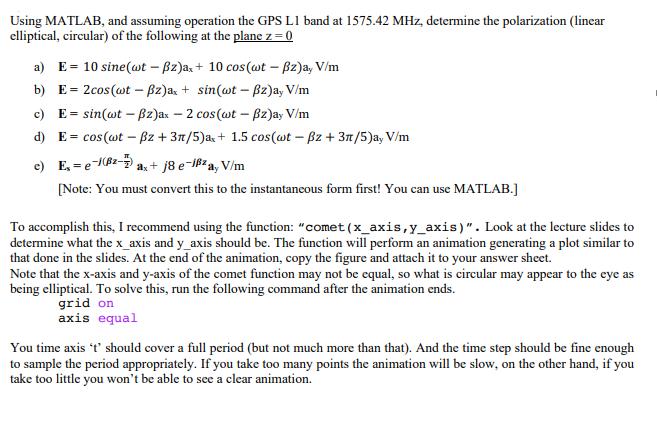Answered step by step
Verified Expert Solution
Question
1 Approved Answer
Using MATLAB, and assuming operation the GPS L1 band at 1575.42 MHz, determine the polarization (linear elliptical, circular) of the following at the plane

Using MATLAB, and assuming operation the GPS L1 band at 1575.42 MHz, determine the polarization (linear elliptical, circular) of the following at the plane z = 0 a) E= 10 sine (wt - Bz)ax + 10 cos(wt - Bz)ay V/m b) E= 2cos (wt - Bz)ax+ sin(wt - Bz)ay V/m c) E= sin(wt - Bz)ax 2 cos (wt - Bz)ay V/m - d) E= cos(wt - Bz+3/5)a+ 1.5 cos(wt- z + 3x/5)ay V/m c) E = el(8-) ax + j8 e-zay V/m Fe [Note: You must convert this to the instantaneous form first! You can use MATLAB.] To accomplish this, I recommend using the function: "comet (x_axis,y_axis)". Look at the lecture slides to determine what the x_axis and y_axis should be. The function will perform an animation generating a plot similar to that done in the slides. At the end of the animation, copy the figure and attach it to your answer sheet. Note that the x-axis and y-axis of the comet function may not be equal, so what is circular may appear to the eye as being elliptical. To solve this, run the following command after the animation ends. grid on axis equal You time axis 't' should cover a full period (but not much more than that). And the time step should be fine enough to sample the period appropriately. If you take too many points the animation will be slow, on the other hand, if you take too little you won't be able to see a clear animation.
Step by Step Solution
★★★★★
3.45 Rating (158 Votes )
There are 3 Steps involved in it
Step: 1

Get Instant Access to Expert-Tailored Solutions
See step-by-step solutions with expert insights and AI powered tools for academic success
Step: 2

Step: 3

Ace Your Homework with AI
Get the answers you need in no time with our AI-driven, step-by-step assistance
Get Started


